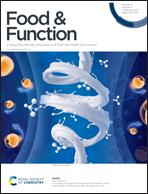In silico-determined compound from the root of Pueraria lobate alleviates synaptic plasticity injury induced by Alzheimer's disease via the p38MAPK-CREB signaling pathway†
Abstract
Pueraria lobata is utilized as a food source in China. The aim of this study is to combine virtual screening and molecular dynamics predictive model to screen out the potential synaptic plasticity-maintaining components from the root of P. lobate and to verify it by employing the amyloid β-injected rats’ model. Eighteen compounds were identified by HPLC-MS/MS; puerarin manifested the most potential to form a stable complex with calcium/calmodulin kinase IIα (CaMK IIα), which is the key protein in synaptic plasticity by the in silico study. The further in vivo assay showed that puerarin could elevate the synaptic thickness, density, and length, relieve calcium overload, regulate the expression of CaMK IIα, and other p38MAPK-CREB signaling pathway-related biochemical criteria. The behavioral test also verified the results. Results have confirmed that the root of P. lobate can work anti-AD by maintaining the synaptic plasticity and proved the reliability of using the in silico predictive model to determine active ingredients from the natural product.



 Please wait while we load your content...
Please wait while we load your content...